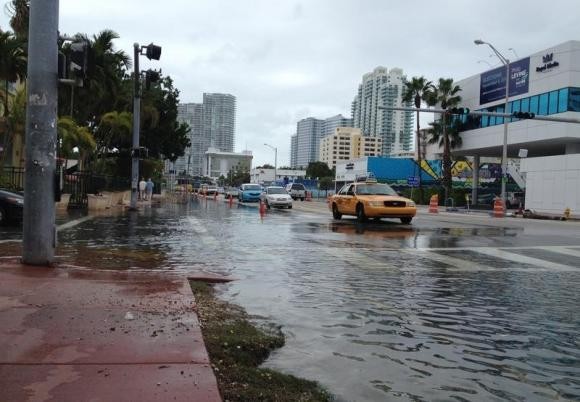Major American Cities Could Experience 30 Days of Flooding Yearly, NOAA Says
| Marco Foronda | | Dec 19, 2014 09:24 AM EST |
(Photo : REUTERS/ZACHARY FAGENSON) Flooding at Alton Road and 10th Street is seen in Miami Beach, Florida on November 5, 2013.
Planning to reside in New York or San Francisco in the near future? You might want to rethink your plan.
A new study from the National Oceanic and Atmospheric Administration (NOAA) released Thursday says that a majority of U.S. coastal areas will likely be inundated by 30 or more days of flooding a year by 2050.
Like Us on Facebook
Annapolis, Wilmington, N.C., and Washington, D.C. are already experiencing the worsening flood situation. By 2020, Baltimore, Atlantic City and Port Isabel, Texas will join the list. Within the next 35 years, most of the cities in the Mid-Atlantic, Gulf and Pacific coasts will be dealing with routine flooding.
The study blames the continuous rising of sea levels on global warming. NOAA added that coastal communities are starting to experience the annoying sunny days and urban flooding these days.
"This is sea level rise. Unfortunately, once impacts are noticed, they will become commonplace rather quickly. We find that in 30 to 40 years even modest projections of global sea level rise will increase instances of daily high tide flooding to a point requiring an active, and potentially costly, response," explained William Sweet of NOAA and a co-author of the study.
The study did not include the Miami area because Hurricane Andrew destroyed NOAA tide stations in the area in 1992. The result is that continuous 50-year data set for the area does not exist.
NOAA also recorded 2014 as the hottest year and this because of global warming. Effects of climate change are now becoming visible in different cities in the United States and other major areas of the world.
Cities like New York, Chicago and San Diego have started to plan ahead, and are committed to better forecasting, natural buffer zones featuring wetlands and sand dunes, storm-proof infrastructure like sea walls and rules limiting building along vulnerable coastlines.
The study was published in Earth's Future, a journal of the American Geophysical Union.
TagsNOAA, global warming, sea level, urban flooding, flooding, coastal areas
©2015 Chinatopix All rights reserved. Do not reproduce without permission
EDITOR'S PICKS
-

Did the Trump administration just announce plans for a trade war with ‘hostile’ China and Russia?
-

US Senate passes Taiwan travel bill slammed by China
-

As Yan Sihong’s family grieves, here are other Chinese students who went missing abroad. Some have never been found
-

Beijing blasts Western critics who ‘smear China’ with the term sharp power
-

China Envoy Seeks to Defuse Tensions With U.S. as a Trade War Brews
-

Singapore's Deputy PM Provides Bitcoin Vote of Confidence Amid China's Blanket Bans
-

China warns investors over risks in overseas virtual currency trading
-

Chinese government most trustworthy: survey
-

Kashima Antlers On Course For Back-To-Back Titles
MOST POPULAR
LATEST NEWS
Zhou Yongkang: China's Former Security Chief Sentenced to Life in Prison

China's former Chief of the Ministry of Public Security, Zhou Yongkang, has been given a life sentence after he was found guilty of abusing his office, bribery and deliberately ... Full Article
TRENDING STORY

China Pork Prices Expected to Stabilize As The Supplies Recover

Elephone P9000 Smartphone is now on Sale on Amazon India

There's a Big Chance Cliffhangers Won't Still Be Resolved When Grey's Anatomy Season 13 Returns

Supreme Court Ruled on Samsung vs Apple Dispute for Patent Infringement

Microsoft Surface Pro 5 Rumors and Release Date: What is the Latest?










